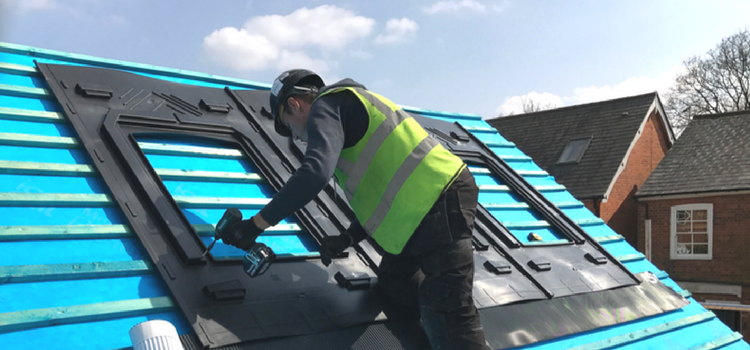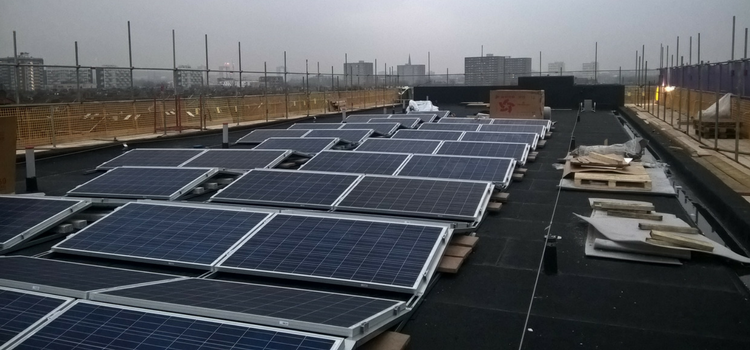
There are as many forms of solar panel mounts as there are places to put them. Each option comes down to the same purpose - to fix the panels in a position to best receive the sun’s energy, while being safe and resistant to adverse weather like high wind and snow.
Roofs make an ideal location for solar arrays - they’re out of the way, make use of dead space and are more likely to be free from shading. As the most popular option, many different methods of rooftop mounting have been developed over the years, from standard fixings on top of the surface, to integrated finishes and specialist solar tiles.
While less common in residential environments, ground mounted installations are well suited to high-volume commercial or utility solar generation. Panels are generally installed on metal frames secured into the ground with a concrete base or pile-driven poles. The freedom of an open space means you can choose the arrangement and tilt of panels to get the highest output.

When developed with an ecological mindset, ground mounts can provide space for undisturbed wildlife or agricultural grazing.
Roof mounted systems work well because the space cannot be used for any other purpose and planning permission is either unnecessary (see planning requirements) or is relatively easy to obtain, unless the building is listed or in a conservation area.
Roofs can, however, be problematic from a structural point of view, as the loads imposed by the system can be significant (both down weight and ‘wind uplift’). Many roofs are not over engineered: they are not made to take additional loads that were never envisaged at the design stage. In addition the roof structure or covering may present a problem. Warm roofs are sometimes problematic, as are roofs containing asbestos.
Ground mounted systems are ideal where space is not limited and there is an easy cable route back to the incoming electricity supply. They can be oriented for maximum output and are often looked on favourably by planning departments where a roof mounted system might fail (for example on a listed building).

Of course, there are other places on a building besides the roof where you can install solar. That’s where building integrated photovoltaics (BIPV) come in. They’re specialist construction materials that replace common elements of the property structure and generate power from the sun. Examples include solar cladding and solar glass. While generally not as efficient as traditionally mounted panels, they are well suited to buildings without much roof or ground space, and offer savings on the regular materials they replace.
When installing PV on a roof, you generally don’t have much control over the direction the panels face (unless the roof is flat). Here is the UK, the best orientation for solar is south - this is because the panels will face the sun at its highest point (noon) for maximum energy generation. In some instances, however, an east-west mounting is preferred, either to skew output towards the morning and evening or to maximise the available space on a flat roof. (When all panels point the same way, you have to leave gaps for shading, while with east-west you can arrange the rows in a concertina formation.)

Since the maximum output is when the sun is directly overhead, why not rotate the system so this is always the case? That’s exactly what solar trackers do, using motors to tilt the panels throughout the day - or even the year, as the sun’s angle changes. Due to their weight, tracking systems almost always have to be installed on the ground, and they do come with a higher price tag and maintenance costs. Expected output can be up to 35% higher than a static mount, though we’ve seen real world uplift of 45%!
Whichever way you mount your PV system, it’s vital to keep it protected. Birds in particular can be a problem for rooftop installations, as they see the space under panels as an ideal nesting spot. Unfortunately this can cause damage to the system and the roof. You can combat this with specialist PV bird protection - spikes or mesh that deter the animals without harming them.
To give you and us peace of mind, we always use high quality accredited products. We do not buy pre-assembled kits; instead we source components individually ensuring we can always buy at the best prices.
Whichever mounting system you choose, we can most likely source and install it for you. Please get in touch for advice on your project or a free quote.
It is important that your mounting systems lasts as long as your solar system - in other words 20 to 30 years minimum. For this to be the case it needs to weatherproof, durable and utilise secure fixings. Furthermore, it is important that the system complies with Building Regulations. The installation must not compromise the structural integrity or the fire safety of the building.
In order to qualify for the Feed-in Tariff, solar systems sized below 50kWp always had to comply with the Microgeneration Certification Scheme (MCS). In 2016, MCS also introduced a specific mounting system certification standard (MCS012) to set standards for Building Regulations compliance (durability, weather tightness and fire resistance). Now installations must comply with MCS to be eligible for an export tariff.
As part of our product selection process, we check our mounting systems achieve the necessary compliance.
Copyright © Spirit Energy 2026 · info@spiritenergy.co.uk · 0118 951 4490
Jobs and Careers
Interested in joining the Spirit team? Email jobs@spiritenergy.co.uk
Spirit House, 25 Albury Close, Reading, RG30 1BD
(Location formerly known as 44 Portman Road, Reading, RG30 1EA)
Spirit Energy is the trading name of Spirit Solar Ltd · UK Company Number 07138647
Although care is taken to ensure that the information on our website (www.spiritenergy.co.uk) and any guides, calculators or checklists provided by us, electronically or otherwise, are accurate and up-to-date, we cannot accept any responsibility for mistakes or omissions. We enter into no express or implied conditions, warranties, terms or representations regarding the quality, accuracy or completeness of the information. We exclude to the extent lawfully permitted all liability for loss or damage, whether direct, indirect or consequential arising out of your use of our website or any guides, calculators or checklists provided by us, or from any information or omission contained in our website or any guides, calculators or checklists provided by us.